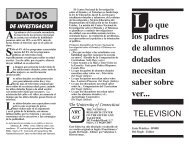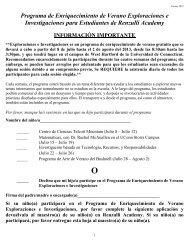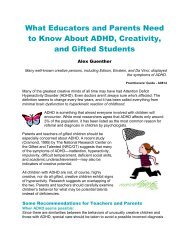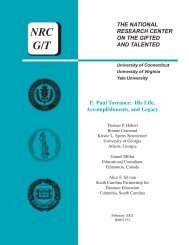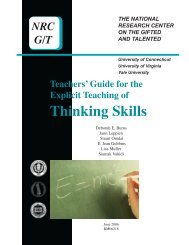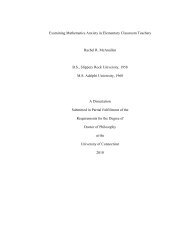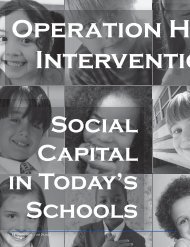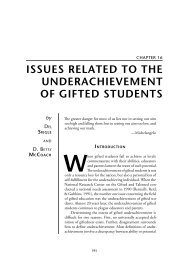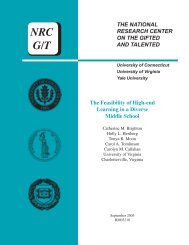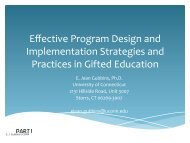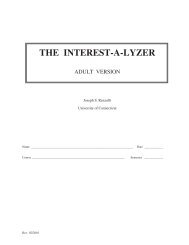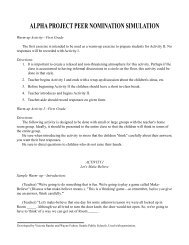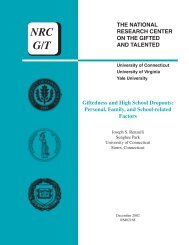Diversity and Developing Gifts and Talents: A National Call to Action
Diversity and Developing Gifts and Talents: A National Call to Action
Diversity and Developing Gifts and Talents: A National Call to Action
Create successful ePaper yourself
Turn your PDF publications into a flip-book with our unique Google optimized e-Paper software.
<strong>Diversity</strong> <strong>and</strong> <strong>Developing</strong><strong>Gifts</strong> <strong>and</strong> <strong>Talents</strong>A <strong>National</strong> <strong>Call</strong> <strong>to</strong> <strong>Action</strong>April 2009
The Association for the GiftedCouncil for Exceptional ChildrenBoard Members of The Association for the GiftedSusan Johnsen, PresidentCheryll AdamsSherrie BossermanDebbie Clell<strong>and</strong>Tracy L. CrossKen DicksonElaine DumasMonique FelderJennifer L. JollyDiane MontgomeryJulia Link RobertsJennifer RobinsKaren RollinsSneha Shah-ColtraneCharmaine ShutivaDel SiegleGloria TaradashAbout The Association for the Gifted (TAG): TAG’s primary purpose is <strong>to</strong> promote the welfare <strong>and</strong> educationof children <strong>and</strong> youth with gifts, talents, <strong>and</strong>/or high potential. TAG strives <strong>to</strong> improve educational opportunitiesfor individuals from all diverse groups with gifts, talents, <strong>and</strong>/or high potential; sponsor <strong>and</strong> fosteractivities <strong>to</strong> develop the field of gifted education, such as the dissemination of information, the conduc<strong>to</strong>f research, <strong>and</strong> other scholarly investigations; support <strong>and</strong> encourage specialized professional preparationfor educa<strong>to</strong>rs of individuals with gifts, talents, <strong>and</strong>/or high potential, as well as for professional persons inrelated areas; work with organizations, agencies, families, or individuals whose purposes are consistentwith its own. For more information, visit http://www.cectag.org.Copyright ©2009 by The Association for the Gifted, Council for Exceptional Children, 1110 N. GlebeRoad, Suite 300, Arling<strong>to</strong>n, VA 222012
Valuing <strong>Diversity</strong>:Changing Our ThinkingIntroduction<strong>Diversity</strong> <strong>and</strong> excellence are each essential <strong>to</strong> the realization ofideals in a democratic society. These ideals have been the corners<strong>to</strong>neof our achievements as a society. <strong>Diversity</strong> has been a<strong>to</strong>pic of discussion in America for decades. Embedded in discussionsof diversity <strong>and</strong> excellence are race, culture, ethnic, class,gender, sexual orientation, <strong>and</strong> linguistic issues. Nowhere arethese issues more evident than in education. As our society continues<strong>to</strong> become more diverse, it is even more important thatwe develop the great variety of gifts <strong>and</strong> talents of all children<strong>and</strong> youth in our nation.These Things We Take<strong>to</strong> Be Self-Evident . . .How the PiecesFit Together . . .NeedThe need for a national call <strong>to</strong> action about diversity <strong>and</strong> developinggifts <strong>and</strong> talents derives from the continuing <strong>and</strong> significantunderrepresentation of specific groups receiving educationalservices for the gifted <strong>and</strong> talented. This underrepresentationbelies the premise that the capacity for exceptional achievementexists across racial, ethnic, language, <strong>and</strong> economic groups aswell as some categories of disability. With all children <strong>and</strong> youth,expressions of potential differ as a result of family background<strong>and</strong> experiences with social institutions. As we continue <strong>to</strong> implementtraditional educational policies <strong>and</strong> practices, we ignorethese differences <strong>and</strong> contribute <strong>to</strong> the inequities. Our schoolsmust reflect society’s changing values about excellence <strong>and</strong> theneeds of its people.Ideas of capability are neither static nor value-free, but changeas society evolves. The U.S. Census Bureau projects rapidlyincreasing percentages of Hispanic, Asian American, AfricanAmerican, Native American, <strong>and</strong> multiracial citizens. Otherchanges in how Americans live their lives, such as lifestyle, familystructure, or use of technology, accompany our changingpopulation. We must move <strong>to</strong>ward ensuring equitable outcomesfor all children <strong>and</strong> youth in educational programs.Despite the emergence of promising practices for recognizing<strong>and</strong> providing appropriate educational services for a diversepopulation, national data from the Office for Civil Rights showlittle evidence of positive change. Promising procedures are discontinuedor never adopted for many reasons. The reasons maybe as simple as children not succeeding because their behaviorconflicts with teacher beliefs about diversity <strong>and</strong> giftedness. Or,the reasons may be as complex as entrenched policies that prohibitthe implementation of promising practices. America mustembrace diversity as a rich source of excellence.3
What Will YOU Do?A wide variety of persons must be involved in preparing schoolpersonnel for general education <strong>and</strong> specialized educationalservices. These persons may be drawn from public school faculties,university faculties, parents, primary caregivers, <strong>and</strong> communityresources <strong>to</strong> deliver instruction. Prospective teachers ofthe gifted <strong>and</strong> talented <strong>and</strong> other school personnel will then havereality-based information.Preparation programs for educa<strong>to</strong>rs must:• Emphasize multicultural sensitivity.• Underst<strong>and</strong> unique signs of giftedness in diverse learners.• Design classroom structures that recognize <strong>and</strong> nurture diversetalents.• Empower diverse students <strong>to</strong> exhibit their gifts <strong>and</strong> talents.• Design strategies for working effectively within diverseschools <strong>and</strong> communities.• Exp<strong>and</strong> field experiences <strong>to</strong> better underst<strong>and</strong> the schoolculture of diverse giftedness.• Collaborate with schools in providing services for gifted <strong>and</strong>talented students from diverse backgrounds.• Empower administra<strong>to</strong>rs <strong>to</strong> create environments that nurturediversity.Educa<strong>to</strong>r recruitment, preparation, <strong>and</strong> development includesystematic efforts <strong>to</strong> involve personnel from diverse ethnic <strong>and</strong>language backgrounds <strong>and</strong> <strong>to</strong> prepare educa<strong>to</strong>rs for effectivepractice with diverse groups of students.Ensuring Equitable Curriculum<strong>and</strong> Learning EnvironmentsCurriculum is the sum of experiences that help each studentdevelop his or her talents. It is more than instruction, materials,or disparate programs. Curriculum should be challenging, multicultural,st<strong>and</strong>ards-based, <strong>and</strong> respectful of student interests.Instruction should be purposefully <strong>and</strong> strategically matched <strong>to</strong>learner background, experience, language, <strong>and</strong> talent, balancingneeds for learner-directed <strong>and</strong> teacher-directed strategies.It is critical that the curricula focus on developing diverse gifts<strong>and</strong> talents that are connected <strong>to</strong> valued areas of adult activity.Within an ethical framework, each child’s strengths must bevalued, described, <strong>and</strong> nurtured. This process recognizes thatstudents are, <strong>and</strong> will be, a part of a larger society.5
Making curriculum meaningful <strong>to</strong> the learner <strong>and</strong> having thatcurriculum linked <strong>to</strong> diversity in real-world accomplishments arethe keys <strong>to</strong> individualizing instruction. The curriculum must berigorous, relevant, <strong>and</strong> respectful. Students must have the opportunity<strong>to</strong> recognize their individual worth <strong>to</strong> society as well associety’s value <strong>to</strong> them.We must maintain high academic st<strong>and</strong>ards. The key conceptmust be that a rigorous but not a rigid curriculum is designed foreach gifted learner. Rigor is not diminished when different waysof knowing are recognized.We must respect each student’s culture <strong>and</strong> background whileteaching skills that may seem <strong>to</strong> oppose his or her belief systems,such as questioning authority <strong>and</strong> accepting that girls canbe scholarly <strong>and</strong> boys can be artists <strong>and</strong> dancers. Curriculummust, therefore, be arranged so that it is possible for each student<strong>to</strong> learn at the edge of his or her ability in valued areas ofadult activity.What Will YOU Do?To accomplish these goals, we need <strong>to</strong>:• Study state <strong>and</strong> national policies <strong>to</strong> ensure equitable outcomes.• Acknowledge that teachers do not need <strong>to</strong> be experts in allcultures, but do need <strong>to</strong> be sensitive <strong>to</strong> differences that influencelearning.• Provide options for students <strong>to</strong> have educational experiencesat the high edge of their abilities.• Acknowledge that some learners are more capable than othersat some tasks at the same point in time.• Provide multiple learning services such as opportunities forinteracting with high-performing peers, acceleration, <strong>and</strong>enrichment.• Establish men<strong>to</strong>rships in worthwhile lines of adult activityfor students at all educational levels.• Provide experiences for students <strong>to</strong> be involved in adultfields.Curriculum <strong>and</strong> learning environments designed <strong>to</strong> supportdiversity <strong>and</strong> excellence are delivered in ways that are comprehensive,flexible, fluid, <strong>and</strong> research-based. Educational servicesmust consider family <strong>and</strong> student preferences for individual orcooperative learning. These services must provide opportunitiesfor students <strong>to</strong> move ahead in any area of learning.6
Hints <strong>and</strong> Clues . . .Finding GiftednessThe recognition of potential requires that st<strong>and</strong>ards of excellencemust be adapted <strong>to</strong> the notion that advanced expression in anyendeavor is an authentic measure.Recognition of diverse gifts <strong>and</strong> talents is not so obvious. Apurposeful activity within a professionally prepared environmentwill reveal the varied hints <strong>and</strong> clues of this potential.Assessment of potential is a dynamic process of “looking out” forthose who show a propensity <strong>to</strong> advance in areas related <strong>to</strong> thereal world of people. Present performance is linked <strong>to</strong> future behavior.The hints <strong>and</strong> clues of potential include motivation <strong>and</strong>volition.Watching for the Spark . . .What Will YOU Do?Self-initiated learning is one of the clues <strong>to</strong> developing a gift ortalent. It is the responsibility of society <strong>to</strong> foster excellence <strong>to</strong> thedegree that the child wants <strong>to</strong> <strong>and</strong> is willing <strong>to</strong> respond. Children<strong>and</strong> youth are rewarded with esteem <strong>and</strong> a strong belief in theirown abilities when they are engaged in studies at their own levelof interest <strong>and</strong> strength.To accomplish these goals, we need <strong>to</strong>:• Shift student assessment from static <strong>to</strong> dynamic <strong>and</strong> authentic(performance-based) strategies.• Consider resilience <strong>and</strong> high motivation <strong>to</strong> achieve in aworthwhile line of human endeavor a significant clue <strong>to</strong> unusualpotential.• Encourage the motivation of students who show signs <strong>and</strong>hints of high-performance capability that might be maskedby disability or experience.• Establish a national initiative for developing model projects<strong>to</strong> highlight the manifestations of talents within specific social,cultural, linguistic, racial, <strong>and</strong> ethnic groups.Including <strong>Diversity</strong> in ResearchResearch is the foundation upon which we base our educationaldecision-making. Appropriate <strong>and</strong> purposeful st<strong>and</strong>ards-basedcurricula rely on research that has equitable representation of allaspects of <strong>to</strong>day’s changing populations. Research guiding giftedservices must be designed <strong>to</strong> support diversity <strong>and</strong> excellence.Past trends in research have ignored the experiences of children<strong>and</strong> youth from diverse backgrounds who are gifted <strong>and</strong> talented.To date, little disaggregation of data has been done for thesediverse populations.7
Including diverse voices <strong>and</strong> evidence of learning outcomes ofstudents from diverse backgrounds challenges <strong>and</strong> changes theunderst<strong>and</strong>ing of needs in research.We believe that research about all aspects of gifted educationmust represent <strong>to</strong>pics relevant <strong>to</strong> diverse populations <strong>and</strong> bebased in methods that advance underst<strong>and</strong>ing of diversity.What Will YOU Do?To accomplish these goals, we need <strong>to</strong>:• Propose research recommendations that demonstrate acommitment <strong>to</strong> diversity.• Encourage professional journal edi<strong>to</strong>rs <strong>to</strong> prioritize diversityas a criterion for publication.• Evaluate research <strong>and</strong> evidence-based learning strategieswith a critical eye for the inclusion of diversity.• Encourage high-quality research methodologies sensitive <strong>to</strong><strong>to</strong>pics relevant <strong>to</strong> diverse populations.• Recruit researchers from diverse backgrounds.What Will YOU Do?SummaryThis call <strong>to</strong> action for the education of children <strong>and</strong> youth fromdiverse backgrounds requires advocacy <strong>and</strong> a shift in thinking<strong>and</strong> practice. This shift m<strong>and</strong>ates that educa<strong>to</strong>rs view students<strong>and</strong> educational services in a fresh <strong>and</strong> different manner. It callsfor a dramatic departure from the current educational practicesin states <strong>and</strong> local school systems across our nation.We believe that by dealing with the issues surrounding diversity<strong>and</strong> excellence in education, our country will be stronger. Bycommitting <strong>to</strong> develop the great variety of gifts <strong>and</strong> talents of ournation’s youth, we enhance both their potential <strong>and</strong> the potentialof our country.You are invited <strong>to</strong> embrace the goals proposed in this nationalcall <strong>to</strong> action <strong>and</strong> decide how you will be a part of this effort forchange.8



